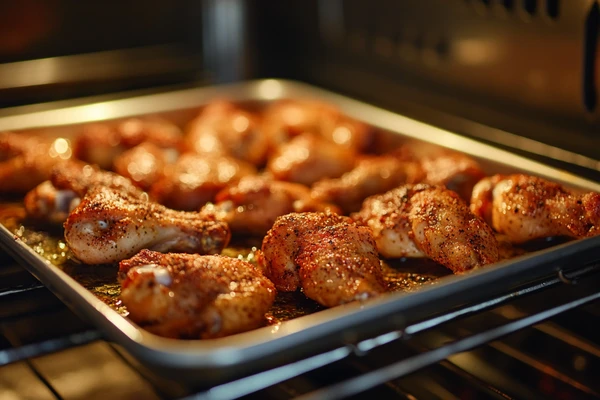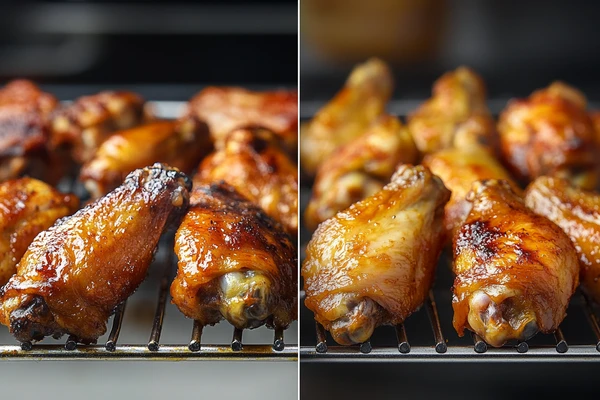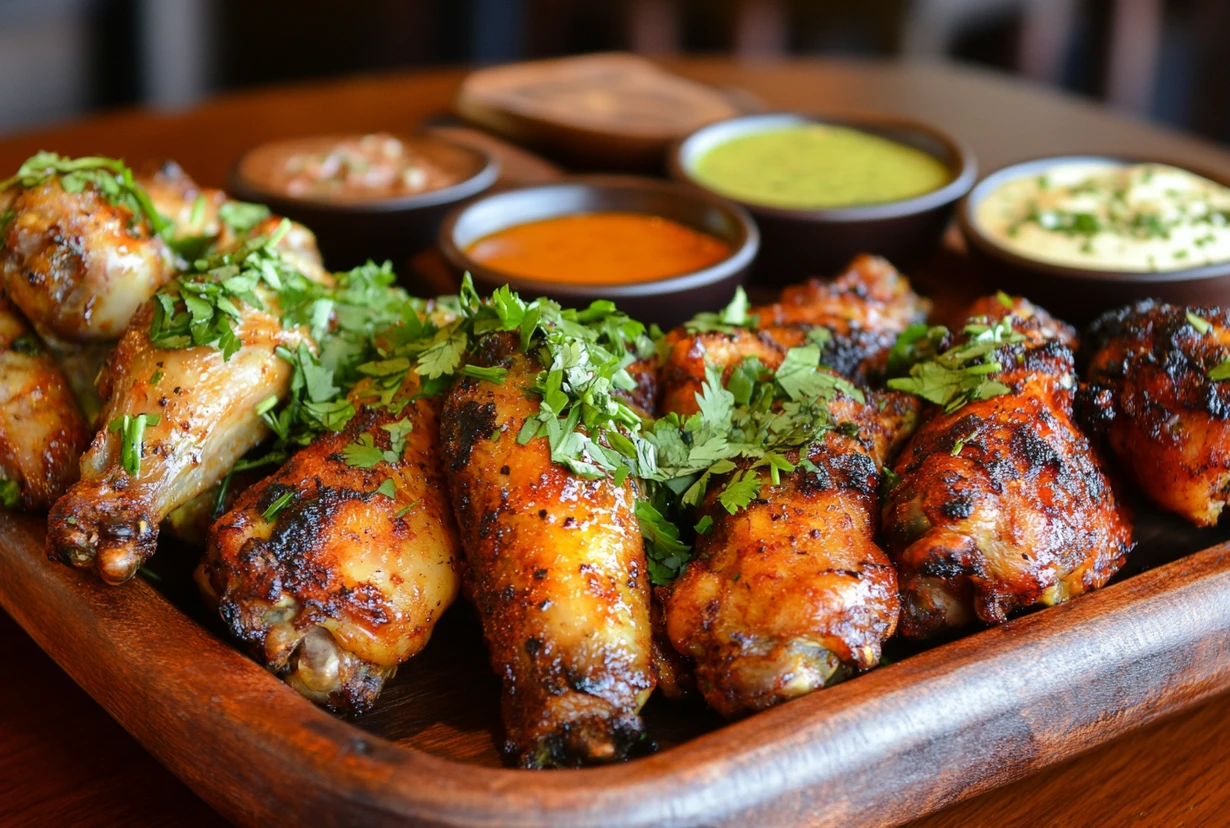When it comes to making perfectly crispy and juicy chicken wings, one common question arises: Should I bake wings at 350 or 400? The temperature you choose can significantly impact the flavor, texture, and overall outcome of your wings. Whether you’re aiming for tender, fall-off-the-bone wings or a deliciously crispy finish, finding the right baking temperature is essential.
Introduction
Chicken wings are a versatile and crowd-pleasing dish, perfect for casual meals, parties, or even a snack to enjoy on your own. While frying wings often steals the spotlight, baking is a healthier and equally delicious option. However, the key to achieving wings that are perfectly crispy on the outside yet juicy and tender on the inside lies in choosing the right baking temperature. This leads many to wonder, Should I bake wings at 350 or 400?
The temperature you select can significantly impact the texture and flavor of your wings. Baking at 350 degrees provides a slower, gentler cook that ensures even heating, while 400 degrees delivers that signature crispiness much faster. In this article, we’ll explore the pros and cons of each temperature, discuss tips for baking wings to perfection, and help you decide which method is best suited to your needs.
Understanding the Science of Baking Chicken Wings
The Role of Temperature in Cooking Wings
Baking chicken wings isn’t just about throwing them into the oven; the temperature you choose plays a significant role in determining the texture and flavor. Lower temperatures allow the heat to penetrate slowly, ensuring the meat cooks evenly and remains tender. This method is especially useful for locking in juiciness but may not produce the crispy skin many wing lovers crave.
How Higher Temperatures Affect Wings
When baking at higher temperatures, the intense heat works to crisp up the skin quickly while caramelizing the natural sugars in the meat and seasonings. This results in the golden-brown, crunchy exterior that many people find irresistible. However, higher heat can also cause the wings to dry out if they’re left in the oven too long. Striking the right balance is key to achieving perfectly baked wings.
Baking Wings at 350 Degrees: Pros and Cons

The Benefits of Baking Wings at 350 Degrees
Baking wings at 350 degrees is a great choice if you prioritize tenderness and even cooking. The lower temperature ensures the meat cooks slowly, allowing the juices to remain intact. This method is especially useful when preparing larger wings or when using marinades that need time to soak in and enhance flavor. Additionally, baking at 350 degrees reduces the risk of overcooking, making it a forgiving option for beginners.
Another advantage is that this temperature works well for wings baked alongside other dishes requiring a similar heat level, adding convenience when preparing a multi-course meal. While wings baked at 350 degrees might take longer, the payoff is succulent meat that stays moist and flavorful.
The Drawbacks of Baking Wings at 350 Degrees
The biggest downside to baking wings at 350 degrees is the lack of crispiness. Since the temperature isn’t high enough to render the skin fats quickly, the wings can come out with a softer texture, which may not appeal to those who love a crunch. Additionally, the extended cooking time might feel inconvenient if you’re in a hurry or preparing for a last-minute gathering.
To counter this, some cooks recommend finishing the wings under the broiler for a few minutes to add a crispy exterior without sacrificing the tender interior. While this step adds an extra layer of effort, it bridges the gap between tenderness and crispiness.
Tips for Perfect Wings at 350 Degrees
- Always preheat the oven to ensure consistent cooking.
- Place wings on a wire rack over a baking sheet to allow hot air to circulate evenly around them.
- For added crispiness, pat the wings dry with a paper towel before seasoning.
Baking Wings at 400 Degrees: Pros and Cons
The Benefits of Baking Wings at 400 Degrees

Baking wings at 400 degrees is the go-to method for those who prioritize crispy, golden-brown skin. The higher temperature renders the fat in the skin quickly, creating a satisfying crunch. This method also significantly reduces cooking time, making it ideal for when you’re short on time or preparing multiple batches.
The intense heat works wonders for locking in flavor, especially if your wings are seasoned with spices or coated in a glaze. As the sugars in marinades caramelize, they form a delicious crust that adds to the overall appeal.
The Drawbacks of Baking Wings at 400 Degrees
Despite its benefits, baking at 400 degrees requires careful attention. The higher temperature can lead to overcooked or dry wings if they’re left in the oven too long. Smaller wings, in particular, are more susceptible to drying out when baked at this heat level.
For best results, you’ll need to monitor the cooking process closely and consider flipping the wings halfway through to ensure even crispiness. Adding parchment paper or lightly greasing the baking sheet can also help prevent sticking and charring.
Comparing Baking at 350 vs. 400 Degrees
| Criteria | 350 Degrees | 400 Degrees |
|---|---|---|
| Cooking Time | Longer (50–60 minutes) | Shorter (35–45 minutes) |
| Texture | Juicy and tender | Crispy skin with less moisture retention |
| Risk of Overcooking | Lower risk | Higher risk |
| Best For | Larger wings, slow-cooked flavor | Quick meals, crispy and caramelized wings |
This table highlights how the two methods differ, making it easier for you to decide which temperature suits your preferences.
Tips for Perfect Wings at 400 Degrees
- Use parchment paper or nonstick spray to prevent sticking.
- Flip the wings halfway through for even crispiness.
- Check the internal temperature with a meat thermometer to ensure they reach 165°F.
Which is Best: Bake Wings at 350 or 400 for Different Types of Wings?
Factors to Consider When Choosing a Temperature
The decision to bake wings at 350 or 400 often depends on several factors, including the size of the wings, the marinade used, and the desired texture. Larger wings tend to benefit from the slower, even cooking process at 350 degrees to ensure the inside is cooked through without drying out. Conversely, smaller wings or those without a thick marinade crisp up beautifully at 400 degrees.
Fresh vs. Frozen Wings: Ideal Temperatures
For fresh wings, baking at 400 degrees is typically the better choice, as it ensures the skin becomes golden and crispy while locking in moisture. Frozen wings, on the other hand, may require a two-step process: start at 350 degrees to allow the wings to cook evenly, then increase to 400 degrees for the final few minutes to achieve a crispy exterior.
Balancing Crispiness and Juiciness
If you’re torn between the two temperatures, baking at 375 degrees can offer a middle ground. This method provides a balance between crispiness and juiciness, making it a versatile option when you’re unsure which temperature to choose. Alternatively, you can bake at 350 degrees and finish under the broiler to achieve crispy skin without compromising tenderness.
Quick Temperature Guide for Different Scenarios
| Wing Type or Scenario | 350 Degrees | 400 Degrees |
|---|---|---|
| Fresh, marinated wings | Retains marinade flavors | Crisp exterior with bold flavor |
| Frozen wings | Even cooking, tender | Requires longer initial cook time |
| Larger or thickly coated wings | Juicy and tender | Risk of undercooked interior |
| Small or plain wings | Takes longer to crisp | Quick and crispy finish |
Pro Tip:
No matter the temperature, always let the wings rest for a few minutes after baking. This allows the juices to redistribute, enhancing the overall flavor and texture.
Frequently Asked Questions About Baking Wings at 350 or 400
1. Can I Use a Convection Oven to Bake Wings?
Yes, a convection oven is an excellent choice for baking wings. The circulating hot air helps cook the wings more evenly and crisps up the skin, even at lower temperatures. If using a convection oven, reduce the temperature by 25 degrees (e.g., bake at 325 instead of 350 or 375 instead of 400).
2. How Do I Know When My Wings Are Done?
The safest way to check if your wings are done is by using a meat thermometer. Insert the thermometer into the thickest part of the wing without touching the bone. The internal temperature should read 165°F. Visually, the juices should run clear, and the skin should be golden and crisp.
3. Should I Cover the Wings While Baking?
Covering the wings traps steam, which helps keep them moist but prevents the skin from crisping. If you prefer crispy wings, bake them uncovered. For a combination of tender and crispy, you can cover the wings for the first half of the baking time, then remove the cover and broil for a few minutes at the end.
4. What Seasonings Work Best for Baked Wings?
Baked wings are incredibly versatile and pair well with a variety of seasonings. Popular options include garlic powder, paprika, cayenne pepper, and a drizzle of honey or hot sauce for a sweet and spicy kick. Dry rubs or marinades can be tailored to your preferences, from tangy BBQ to zesty lemon-pepper.
5. Can I Bake Wings at 375 Degrees as a Compromise?
Absolutely! Baking at 375 degrees strikes a balance between the slower cooking process of 350 and the crispiness achieved at 400. This temperature is ideal for those who want a mix of tender meat and a lightly crisp exterior without frequent monitoring.
6. How Can I Reheat Baked Wings Without Losing Their Crispiness?
To reheat baked wings and maintain their crispy texture, use an oven or air fryer. Preheat to 375 degrees, spread the wings out on a baking sheet or in the air fryer basket, and heat for 8–10 minutes. Avoid microwaving, as it can make the wings soggy.
Conclusion: The Verdict on Baking Wings at 350 or 400
When deciding whether to bake wings at 350 or 400, it ultimately comes down to your personal preferences and cooking goals. Baking at 350 degrees is perfect for achieving tender, juicy wings with even cooking, making it a great option for larger wings or when you want to emphasize the flavor of marinades. However, if crispy, golden-brown skin is your top priority, baking at 400 degrees delivers excellent results in less time.
For the best of both worlds, consider combining techniques. Start at 350 degrees to cook the wings thoroughly, then increase to 400 degrees or finish under the broiler for that irresistible crunch. Alternatively, experiment with baking at 375 degrees for a balanced approach that offers both tenderness and crispiness.
Remember, the success of your wings isn’t just about temperature. Preheating the oven, drying the wings before seasoning, and monitoring their progress can all make a significant difference. For an extra burst of flavor, try pairing your perfectly baked wings with a creamy and delicious sauce like this Garlic Parmesan Wing Sauce for an unforgettable meal.
Enjoy your wings, and don’t be afraid to experiment with temperatures and flavors to discover your ideal method!

